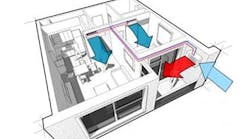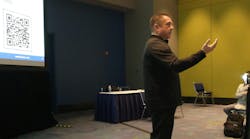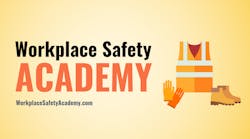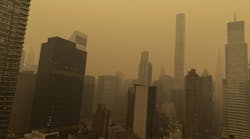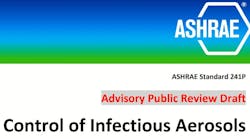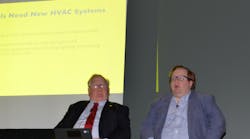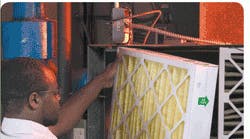Filter maintenance is often maligned and thought of as minor when looking at the overall maintenance program. It is, however, important to the efficient operation of the equipment, and will reduce the amount of labor that will be needed when the annual cleaning is performed.
Additionally, keeping the unit's internal components clean will extend the effective service life of the equipment.
Many problems begin with filtration. The air side issues seen in many pieces of air handling equipment can often be traced to poor filter maintenance.
The whole premise of inserting filters into the airstream is to reduce the particulate that can and will accumulate on the coil surfaces both on the coil face and deep within the coil if not filtered properly. In order to make a difference in the long-term condition of the equipment, two things need to happen.
First, the filters must be sized to cover the entire opening. Use the correct size filters, or insert filler pieces along the margins, to maintain a snug — but not crushing — fit, to prevent air bypass. Be careful to avoid bending or kinking the filter's fiberboard frame. It does little good to provide high quality filters if any portion of the air has free access around the filters.
Second, ensure that the filter is of a quality and rating that will provide the filtration appropriate to the application. The outside environment, along with the type and use of the building, will dictate the quality of the filter media to a great degree. However, the quality shouldn't be allowed to be reduced to a level that allows particulate to pass through and cause coil fouling just to save a few (most often very few) dollars in cost.
Many planned maintenance contracts have filter changes scheduled quarterly. This is, except in some critical cases, often enough to prevent coil difficulties even in rooftop equipment. In some cases, however, such as air handling units inside a building, quarterly may be too frequent, creating waste. In this case, using pressure differential readings across the filters will provide for proper change intervals.
Filters come in a wide range of thicknesses and levels of filtration. Filter selection is important to the operation of the equipment. Refer to the filter guides provided by the unit manufacturer or consult the guides provided by filter manufacturers to determine which filter is right for the application.
There's no substitute for quality maintenance. This is shown by the start-up costs incurred by new customers of service providers who have entered into a contract for full coverage of equipment. The due diligence inspections reveal poor operating conditions that could have been largely avoided if quality maintenance practices had been used over time. And at the very beginning of it all is a filtration program appropriate to the application.
Wayne Riddle is service general manager at Gillette Air Conditioning Co., Inc., San Antonio, TX. The company is Contracting Business magazine's 2010 Commercial Contractor of the Year. Riddle can be reached at 210/735-9235 or by e-mail at [email protected]
Residential Filter Focus: Electrostatic/Electronic Filters
by Robert Scaringe, P.E., Ph.D.
An HVAC system air filter upgrade is one way residential HVAC contractors can simultaneously increase customers' residential indoor air quality (IAQ) and generate more business. The central air-conditioning/heating unit is the perfect appliance for providing cleaner IAQ, but few consumers realize it. Many will buy an electric-powered room air cleaner, which is as logical as using a window air-conditioner in a central air conditioned home. Therefore, it's the contractor’s responsibility to educate consumers and suggest methods to improve IAQ.
A comprehensive assessment must include ventilation and purification. The central air conditioning/heating system is the place to begin any residential IAQ improvement, yet, the fiber filter supplied with most residential HVAC systems has a typical Minimum Efficiency Reporting Value (MERV) rating of 1-4. Low quality filters leave plenty of room for improvement, because they're essentially useless (capturing less than 20% of the contaminates in the 3-10 micron range). Consequently, the evaporator coil itself functions as a filter, and inevitably becomes clogged.
Additionally, these filters do nothing against smaller, respirable particles from contaminants such as smoke and pollen, which can lead to problems for families with allergies or asthma.
The first and most logical choice is to move the customer to a better filter with a higher MERV rating. A higher MERV rating improves filtration effectiveness by trapping more particles by virtue of a tighter weave (such as a pleated filter). This is an acceptable solution if the system blower can tolerate the increase static head pressure on the overall air circulation system.
There's no simple answer to determine whether the existing system can handle the additional pressure drop of the improved filtration. The total pressure drop caused by the indoor coil, air distribution ductwork (both supply and return), registers, and the filter must be accounted for and accommodated by the system blower. A hand-held anemometer can measure the effect the filter has on the air flow into the structure. Fan speed may be modified to minimze this effect at the cost of increased noise. In general, however, a reduction in air flow results in a proportionate increase in the temperature difference required across the coils.
For additional article information, visit http://bit.ly/filterupgrades
Robert Scaringe is president of Mainstream Engineering (www.mainstream-engr.com), Rockledge, FL. He’s been involved in the development of advanced vapor-compression heat pump systems for more than 33 years. He currently holds more than 70 HVAC-related patents and has written for more than one hundred technical publications.
Delaying Filter Changes Can be Costly
by Ronald Cox
The small amount of money your customers may be able to save by reducing or eliminating air filter purchases pales in comparison to the energy and operating costs that can be saved by maintaining a robust air filtration maintenance program.
While purchasing fewer filters may reduce initial expenses, delaying filter change-outs causes the filter to run more days at peak airflow resistance and energy usage. It doesn't take long for peak usage cost to offset any savings in the filter price. It comes down to physics; the energy used to operate filters is directly proportional to the airflow resistance of the filters. The more resistance (due to clogged filters that aren’t changed out as frequently as needed), the more energy is needed to push air through the filter.
Delaying filter maintenance also increases CO2 emissions. The extra energy consumed by dirty filters drives up energy production and greenhouse gas emissions, making delayed filter maintenance extremely costly to the environment.
One of the easiest ways your customers can reduce HVAC-related energy costs is to switch to a filter with a lower resistance to airflow. When filters have a lower resistance to airflow, the HVAC system motor needs to overcome less resistance to deliver the required airflow, thus reducing the motor's energy consumption.
Some of your customers may fall into the NIMB (Not in My Budget) trap when it comes to filters. In many cases, one department (and budget) is responsible for purchasing air filters and filter service contracts, while another is responsible for energy expenditures. The filter purchaser can easily and innocently make a costly decision for the enterprise by choosing to buy (or not buy) filters without considering the energy consumption and system operating implications.
Encourage your customers to look beyond the line item purchase price of filters when seeking to reduce overall costs, and instead look at the initial and sustained airflow resistance of different filters.
Ronald Cox, CAFS, is market manager, Kimberly-Clark Filtration. He can be reached at 770/587-7897, or by e-mail at [email protected].
